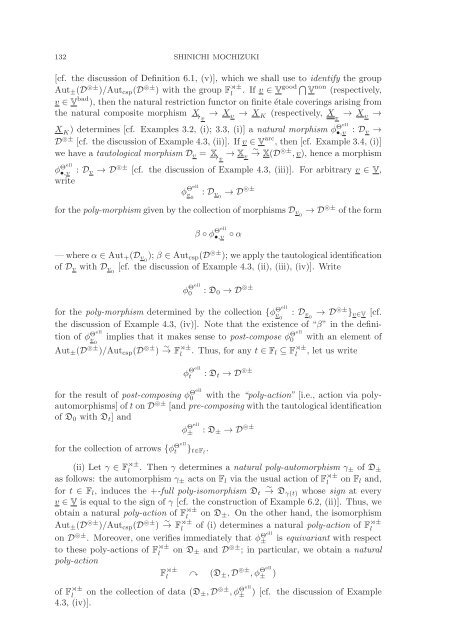Inter-universal Teichmuller Theory I: Construction of Hodge Theaters
Inter-universal Teichmuller Theory I: Construction of Hodge Theaters
Inter-universal Teichmuller Theory I: Construction of Hodge Theaters
Create successful ePaper yourself
Turn your PDF publications into a flip-book with our unique Google optimized e-Paper software.
132 SHINICHI MOCHIZUKI<br />
[cf. the discussion <strong>of</strong> Definition 6.1, (v)], which we shall use to identify the group<br />
Aut ± (D ⊚± )/Aut csp (D ⊚± ) with the group F ⋊±<br />
l<br />
. If v ∈ V good ⋂ V non (respectively,<br />
v ∈ V bad ), then the natural restriction functor on finite étale coverings arising from<br />
the natural composite morphism −→v X → X v → X K (respectively, X v<br />
→ X v →<br />
X K ) determines [cf. Examples 3.2, (i); 3.3, (i)] a natural morphism φ Θell<br />
•,v : D v →<br />
D ⊚± [cf. the discussion <strong>of</strong> Example 4.3, (ii)]. If v ∈ V arc , then [cf. Example 3.4, (i)]<br />
∼<br />
we have a tautological morphism D v = −→v X → X v → X(D ⊚± ,v), hence a morphism<br />
φ Θell<br />
•,v : D v →D ⊚± [cf. the discussion <strong>of</strong> Example 4.3, (iii)]. For arbitrary v ∈ V,<br />
write<br />
φ Θell<br />
v 0<br />
: D v0 →D ⊚±<br />
for the poly-morphism given by the collection <strong>of</strong> morphisms D v0<br />
β ◦ φ Θell<br />
•,v<br />
◦ α<br />
→D ⊚± <strong>of</strong> the form<br />
—whereα ∈ Aut + (D v0 ); β ∈ Aut csp (D ⊚± ); we apply the tautological identification<br />
<strong>of</strong> D v with D v0 [cf. the discussion <strong>of</strong> Example 4.3, (ii), (iii), (iv)]. Write<br />
φ Θell<br />
0 : D 0 →D ⊚±<br />
for the poly-morphism determined by the collection {φ Θell<br />
v 0<br />
: D v0 →D ⊚± } v∈V [cf.<br />
the discussion <strong>of</strong> Example 4.3, (iv)]. Note that the existence <strong>of</strong> “β” in the definition<br />
<strong>of</strong> φ Θell<br />
v 0<br />
implies that it makes sense to post-compose φ Θell<br />
0 with an element <strong>of</strong><br />
Aut ± (D ⊚± )/Aut csp (D ⊚± ) → ∼ F ⋊±<br />
l<br />
.Thus,foranyt ∈ F l ⊆ F ⋊±<br />
l<br />
,letuswrite<br />
φ Θell<br />
t : D t →D ⊚±<br />
for the result <strong>of</strong> post-composing φ Θell<br />
0 with the “poly-action” [i.e., action via polyautomorphisms]<br />
<strong>of</strong> t on D ⊚± [and pre-composing with the tautological identification<br />
<strong>of</strong> D 0 with D t ]and<br />
φ Θell<br />
± : D ± →D ⊚±<br />
for the collection <strong>of</strong> arrows {φ Θell<br />
t } t∈Fl .<br />
(ii) Let γ ∈ F ⋊±<br />
l<br />
. Then γ determines a natural poly-automorphism γ ± <strong>of</strong> D ±<br />
as follows: the automorphism γ ± acts on F l via the usual action <strong>of</strong> F ⋊±<br />
l<br />
on F l and,<br />
∼<br />
for t ∈ F l , induces the +-full poly-isomorphism D t → Dγ(t) whose sign at every<br />
v ∈ V is equal to the sign <strong>of</strong> γ [cf. the construction <strong>of</strong> Example 6.2, (ii)]. Thus, we<br />
obtain a natural poly-action <strong>of</strong> F ⋊±<br />
l<br />
on D ± . On the other hand, the isomorphism<br />
Aut ± (D ⊚± )/Aut csp (D ⊚± ) → ∼ F ⋊±<br />
l<br />
<strong>of</strong> (i) determines a natural poly-action <strong>of</strong> F ⋊±<br />
l<br />
on D ⊚± . Moreover, one verifies immediately that φ Θell<br />
± is equivariant with respect<br />
to these poly-actions <strong>of</strong> F ⋊±<br />
l<br />
on D ± and D ⊚± ; in particular, we obtain a natural<br />
poly-action<br />
F ⋊±<br />
l<br />
(D ± , D ⊚± ,φ Θell<br />
± )<br />
<strong>of</strong> F ⋊±<br />
l<br />
on the collection <strong>of</strong> data (D ± , D ⊚± ,φ Θell<br />
± ) [cf. the discussion <strong>of</strong> Example<br />
4.3, (iv)].
















